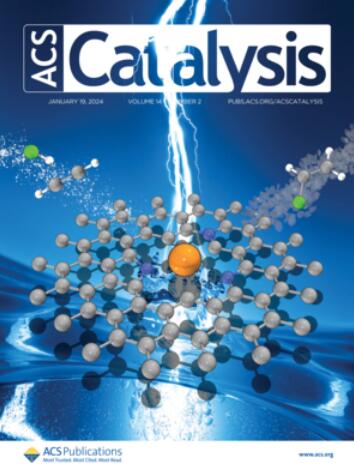部分氯化IrO2(110)表面上C2H6生成C2H4的选择性增强
IF 13.1
1区 化学
Q1 CHEMISTRY, PHYSICAL
引用次数: 0
摘要
改性金属氧化物表面以限制其氧化活性可以提供一种提高对轻烷烃部分氧化的催化选择性的方法。在这项研究中,我们利用程序升温反应光谱(TPRS)和第一性原理微动力学模型研究了C2H6在cl修饰的IrO2(110)表面上的氧化反应。我们发现,在IrO2(110)表面用Cl取代O,通过抑制CO x产物的广泛氧化,可以增强TPRS过程中C2H6转化为C2H4的选择性,同时也可以提高C2H4的产量或在较小程度上改变C2H4的产量,这取决于初始C2H6覆盖率。C2H4选择性随C2H6和Cl覆盖率的增加而增加,但在50%以下达到极限值。在C2H6氧化过程中,Cl的覆盖率变化很小,当Cl的覆盖率达到0.5 ML(单层)时,表面反应性仅略有下降。使用微动力学模型的TPRS模拟预测了C2H4和CO x产物产率作为Cl覆盖率的函数,与实验结果非常吻合。模拟结果表明,C2H6在Cl- iro2(110)上转化为C2H4是由于吸附在阻滞态的C2H3*物质的加氢作用,相邻的位点仅被未反应的HO和Cl物质占据。微动力学模拟表明,远离表面HO基团的h跳变为C2H3*逃离阻塞构型和脱氢提供了相对有效的途径,并且在研究条件下,该过程可以限制C2H4对Cl-IrO2(110)的选择性。总体而言,我们的研究结果表明,cl -取代IrO2(110)增强了C2H6生成C2H4的选择性,并为进一步提高C2H4选择性的反应机制提供了见解。本文章由计算机程序翻译,如有差异,请以英文原文为准。
Enhanced Selectivity for C2H4 Production from C2H6 on Partially Chlorinated IrO2(110) Surfaces
Modifying metal oxide surfaces to limit their oxidizing activity can provide a means of improving catalytic selectivity toward the partial oxidation of light alkanes. In this study, we investigated the oxidation of C2H6 on Cl-modified IrO2(110) surfaces using temperature-programmed reaction spectroscopy (TPRS) and first-principles microkinetic modeling. We find that substituting Cl for O in the IrO2(110) surface enhances the selectivity for C2H6 conversion to C2H4 during TPRS by suppressing extensive oxidation to CO x products, while also either enhancing C2H4 production or altering it to a lesser extent, depending on the initial C2H6 coverage. The C2H4 selectivity increased with increasing C2H6 and Cl coverage, but reached a limiting value below 50%. The Cl coverage changed negligibly during C2H6 oxidation, and the surface reactivity decreased only marginally for Cl coverages up to 0.5 ML (monolayer). TPRS simulations using a microkinetic model predict C2H4 and CO x product yields as a function of the Cl coverage that agree closely with the experimental results. According to the simulations, C2H6 conversion to C2H4 occurs on Cl-IrO2(110) by the hydrogenation of C2H3* species adsorbed in blocked states, in which neighboring sites are occupied only by unreactive HO and Cl species. The microkinetic modeling shows that H-hopping away from surface HO groups provides a relatively efficient route for C2H3* to escape blocked configurations and dehydrogenate, and that this process can limit the C2H4 selectivity on Cl-IrO2(110) under the conditions studied. Overall, our results demonstrate that Cl-substitution into IrO2(110) enhances the selectivity for C2H4 production from C2H6 and provides insights into the reaction mechanism that can guide strategies to further improve the C2H4 selectivity.
求助全文
通过发布文献求助,成功后即可免费获取论文全文。
去求助
来源期刊

ACS Catalysis
CHEMISTRY, PHYSICAL-
CiteScore
20.80
自引率
6.20%
发文量
1253
审稿时长
1.5 months
期刊介绍:
ACS Catalysis is an esteemed journal that publishes original research in the fields of heterogeneous catalysis, molecular catalysis, and biocatalysis. It offers broad coverage across diverse areas such as life sciences, organometallics and synthesis, photochemistry and electrochemistry, drug discovery and synthesis, materials science, environmental protection, polymer discovery and synthesis, and energy and fuels.
The scope of the journal is to showcase innovative work in various aspects of catalysis. This includes new reactions and novel synthetic approaches utilizing known catalysts, the discovery or modification of new catalysts, elucidation of catalytic mechanisms through cutting-edge investigations, practical enhancements of existing processes, as well as conceptual advances in the field. Contributions to ACS Catalysis can encompass both experimental and theoretical research focused on catalytic molecules, macromolecules, and materials that exhibit catalytic turnover.
 求助内容:
求助内容: 应助结果提醒方式:
应助结果提醒方式:


